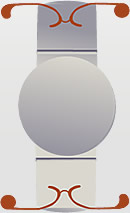Accommodating
How do accommodating lenses work?
 A third lens, the accommodating lens, provides a multifocal effect allowing for both near and distance focus. By moving forward in the back of the eye on small hinges, the lens can change its power in the eye, similar to the process of accommodation of the eye’s natural lens. An example of an accommodating lens is the Crystalens.
A third lens, the accommodating lens, provides a multifocal effect allowing for both near and distance focus. By moving forward in the back of the eye on small hinges, the lens can change its power in the eye, similar to the process of accommodation of the eye’s natural lens. An example of an accommodating lens is the Crystalens.
Crystalens accommodating lens
When light enters a monofocal lens, it is bent to a focus point. As the power of the lens becomes stronger, its ability to bend light more sharply is increased. Since the lens is monofocal, the light can only be bent to one focus point at a time. With monofocal IOLs, the lens bends the light so that it will form a focus point on the retina of the eye. A surgeon can chose an IOL that focuses light best coming from distant objects, or a stronger powered IOL that focuses light better from near objects. However, light cannot be focused from both distant and near objects at the same time with a monofocal lens. Most patients choosing a monofocal lens choose to have good distance focus, and use reading glasses to help with near vision tasks.
In contrast, the Crytstalens incorporates both distance and near capability into a single lens by its ability to change from distance to near power while inside the eye. The Crystalens accomplishes this by use of two small hinges, which allow the lens to move forward and backward slightly inside the eye. By doing so, the lens can change its power in the eye, similar to the process of accommodation of the eye’s natural lens. Hence, the Crystalens is called an accommodating lens, and can provide both near and distance focus.
What are the Pros and Cons of the Crystalens versus other lenses?
The main advantage offered by Crystalens over a traditional, monofocal lens implant is the opportunity to become less dependent on reading glasses for near activities. Activities that were once easily enjoyed without glasses, such as reading or sewing, now require a pair of reading glasses always be available. For people frustrated by the need for reading glasses, multifocal lenses offer a good alternative.
Results from the FDA clinical trial of the Crystalens suggest that most patients who had the lens implanted achieved good distance vision and had improved intermediate range vision, such as that needed to use the computer, more so then patients with traditional monofocal lenses. About 60% of Crystalens patients in the study also reported unaided near vision sufficient to read a newspaper, which also was superior to the monofocal lens group. The remainder did require the additional help of reading glasses in order to see fine newsprint.
Compared to the Crystalens accommodating lens, the ReZoom and ReSTOR multifocal lenses may allow for better near vision, sufficient enough to read newsprint. This was evident in the FDA trial of the ReSTOR multifocal lens; 84% of ReSTOR patients achieved 20/25 distance vision, and near vision which allowed newsprint to be easily read. However, the trade off with multifocal lenses, such as the ReZoom and ReSTOR lenses, may be increased glare and halos at nighttime, as well as less crisp distance vision, versus the Crystalens. As such, the proper lens choice is a matter of personal fit for a patient. Your surgeon can help you decide which lens may be best for you.

